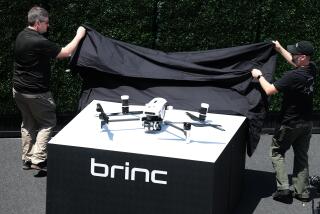Robots give telecommuters a physical presence in the office
Reporting from San Jose — Late one July night, Mountain View Fire Capt. Verne Chestnut and his team were checking out a fire alarm at an office building when he saw movement at the front door.
But the thing waiting there, as if to greet them, was not a person. It was a robot that looked like a Segway scooter with a head.
The robot trailed the crew as they inspected the building and shut off the alarm. Then it spoke to them.
“It was just like, ‘You’re kidding!’ ” Chestnut said. “It was definitely different being met by a robot.”
The machine was voiced by Trevor Blackwell, chief executive of Anybots Inc., the robot-making company whose alarm had sounded. Blackwell, on vacation in Hawaii, was controlling the robot through the Internet.
This scenario, he said, could soon become commonplace as new remote-controlled robots, including Anybots’ QB model, hit the market. Using communications technologies similar to Skype and robotic technologies akin to those used to explore Mars or help defuse bombs in Iraq, the new models cost far less than their predecessors and are designed for more ordinary uses.
“The more robots there are, the easier it will be to work remotely in ways we haven’t thought about before,” said Hyoun Park, an analyst at technology research firm Aberdeen Group.
Blackwell, who founded Anybots nine years ago after leaving Yahoo! Inc., says the $15,000 QB can inspect warehouses or factories remotely or provide tech support. And security firms are likely to be interested, analysts said.
But eventually, robots could also be used to let consumers preview houses or hotels from afar; to let disabled people virtually visit tourist destinations; and to help fashion experts give sartorial consultations from the comfort of their homes to consumers at clothing stores across the country.
Anybots’ competitors include RoboDynamics in Santa Monica, which for two years has sold a robot called TiLR that costs $10,000 and is being targeted for use by remote employees. And InTouch Health in Santa Barbara is building robots for physicians working away from hospitals and other healthcare settings.
Anybots is pitching the QB to companies with remote workers who, when they aren’t being flown into the main office, are meeting with executives via video or teleconferences. Through a robot avatar, Blackwell said, users can wander around and have informal conversations as if they were actually in the office.
The QB robot is controlled using the arrows on the keyboard of an Internet-connected computer. Via a Wi-Fi antenna, it relays video of its surroundings back to its user’s Web browser from its video camera eye and enables users to talk with colleagues through a built-in microphone and speaker.
Users can point to notes on walls and other objects with the laser pointer built into the QB’s other eye. They can display their name or picture on the screen in the center of what looks to be the QB’s sea-green tiara.
But for now, the range of applications for the QB and similar robots is limited by their lack of arms to manipulate things in their environments. Arms tend to make robots more expensive and difficult to use, analysts say.
The QB has some other shortcomings as well. Users can’t tilt its head up or down. Its “neck” can be raised or lowered but not remotely. And it has only one eye-level camera and can’t move its head side to side, so its field of view is narrow.
Still, Anybots hired a “virtual” receptionist, which is operated by Suzanne Brocato from her house in Martinez, Calif., some 60 miles from the company’s headquarters. Whenever she needs to greet a scheduled guest at the office or to virtually attend a company meeting, she fires up a QB.
“Everyone’s so happy to greet the robot,” Brocato said.
Wolverton writes for the San Jose Mercury News/McClatchy.






